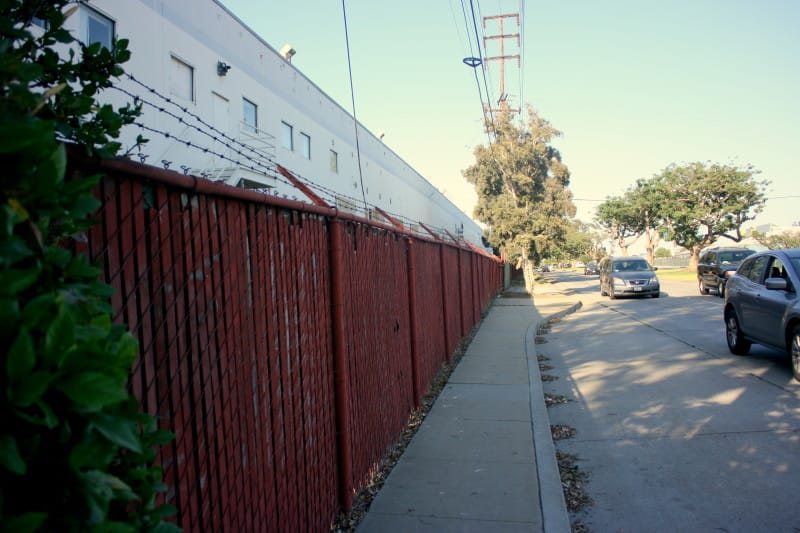
After anti-development advocates successfully killed plans by developer Hines for a mixed-use housing and office project on the former Papermate site across from the future Expo light rail station at 26th Street, a new owner has filed new plans for the site.
And, it’s looking a lot more like a suburban office park, without the housing and the other amenities that would have been included in developer Hines’ proposal to revamp the industrial site for the first time in more than 50 years.
Unlike the developer Hines’ proposal to add more than 400 apartments to the site, along with about 400,000 square feet of new offices, the new proposal by Clarion Partners likely won’t require approval by the City Council.
“The project includes adding 7,499 square feet to the existing 196,317 square-foot building and adaptive re-use of the existing, vacant building for creative office space,” the description of Clarion’s project on the City’s website reads.
“The project will also involve the addition of a one-story subterranean parking structure and the demolition of the easternmost existing building on the site,” the site reads. “The parking structure includes 2 elevators, 2 exit stairs, shower and toilet room, and bicycle storage [for 488 bikes].” according to the City’s website.
There is no mention if Clarion will add a sidewalk on the south side — facing the Expo Metro Rail station — of the parcel where there currently isn’t one. Nor does it appear that Clarion will be breaking up the superblock on which the former Papermate factory sits.
“This project, even as adaptive reuse, will disappoint many of us, but the original Hines proposal failed in even more massive (and likely more permanent) ways to make appropriate use of a challenging site,” said Mayor Kevin McKeown, one of the three Council members who voted against the project in February 2014 after seven years of community meetings and negotiations with Hines.
That project became a lightning rod for anti-growth advocates after the Council narrowly approved it.
Director of MoveLA Denny Zane, a former Santa Monica mayor and current co-chair of Santa Monicans for Renters’ Rights (SMRR), joined forces with local no-growth groups like Residocracy and Santa Monica Coalition for a Livable City, to kill the project.
After a successful referendum drive, the battle-cry of which was “Stop Traffic,” the City Council opted to rescind approval rather than put the project on the ballot. However, with parking being added on the site, it’s likely to increase vehicle traffic since availability of parking is one of the biggest driver of car trips.
Santa Monica lost out on the much needed housing and other amenities, including about $30 million in funding for child care and education, a public road to break up the parcel, and a sidewalk along Olympic, among other things.
“Predictably, this project has moved forward with creative office space and none of the benefits that council negotiated in the previous project, such as affordable and market-rate housing, mixed use services, aggressive traffic management requirements with financial penalties for exceeding caps, cut-through streets, pedestrian improvements, and funding for open space and child care,” said Councilmember Terry O’Day, one of the four who supported the original Hines proposal.
“I am committed to doing the best with what we now have, but am disappointed by the shortsightedness that led us to lose these critical improvements,” he said.
McKeown believes, however, that the fight over the Bergamot Transit Village, the name of the now dead Hines’ project, wasn’t about stopping all growth, but the need for more housing.
“What we learned from the original Hines proposal was that those of us who argued for a higher proportion of housing and less commercial during the original LUCE and Bergamot Area Plan discussions were right,” he said. “With a new Council, I hope we can now make amendments to reflect our community’s true need, which is for more housing.”
The Hines proposal was split 40 percent housing, 60 percent office space, based on the ratios called for in the Bergamot Area Plan.
But it remains unclear when or if the site will get any housing, and other groups who supported killing the Hines project have since fought against other projects and allowing new housing near transit and along commercial corridors.
Armen Melkonians, a civil engineer, and Kate Bransfield, a local realtor, announced Thursday that they would oppose even the modest housing growth proposed in Santa Monica’s Land Use and Circulation Element (LUCE) through a referendum of the upcoming zoning ordinance update. (Correction: Kate Bransfield was identified in an earlier version of this piece as a former member of the Tea Party. Since then, she has written that, though she attended several Tea Party meetings, she never considered herself a member of this group. She describes herself as “a Jeffersonian” who believe in “small, limited government.”)
The LUCE anticipates adding about 4,955 homes to the city by 2030. At a time when all of California is facing a dire housing crisis that is forcing working families to leave the state, even that modest amount of new homes helps, considering that Santa Monica’s population has increased by less than 10,000 since 1960, when the population was about 83,000 people.
